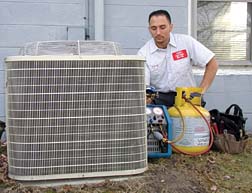A passive system dependent recovery process for small appliances is an effective and efficient method of restoring functionality to these devices. This recovery process relies on the appliance’s internal mechanisms to automatically detect and rectify any issues, minimizing the need for manual intervention.
By implementing this passive system, small appliances can undergo a streamlined recovery process, saving time and effort for the users. Whether it’s a malfunctioning coffee maker or a faulty toaster, this system ensures that the appliance can self-diagnose and resolve problems without requiring external assistance.
With its simplicity and reliability, the passive system dependent recovery process is a valuable feature that enhances the user experience and prolongs the lifespan of small appliances.
What Is A Passive System Dependent Recovery Process?
A passive system dependent recovery process refers to the method of recovering small appliances without active intervention. These systems are designed to automatically recover appliances through a self-regulating mechanism. They work by utilizing sensors or detectors that detect malfunctions or faults in the appliance.
Once a fault is detected, the system triggers a recovery process to restore the appliance to its normal functioning state. The passive nature of these systems eliminates the need for manual intervention, making them convenient and efficient. This recovery process is especially useful for small appliances that may experience frequent malfunctions.
By relying on a passive system, users can save time and effort in troubleshooting and repairing their appliances, allowing for a more seamless and hassle-free experience.
The Importance Of Small Appliances In Everyday Life
Small appliances play a crucial role in our daily lives, performing various tasks efficiently. They simplify our routines and make our lives easier. Whether it’s the morning coffee maker, the toaster for breakfast, or the blender for making smoothies, small appliances have become an integral part of our households.
They save time and effort, allowing us to focus on other important tasks. However, small appliances can also pose problems. They may break down or malfunction, disrupting our daily routines and causing frustration. Repairing or replacing small appliances can be costly, especially if they are not covered by warranty.
Understanding the common issues associated with small appliances can help us prevent and address problems effectively. By taking proper care of these appliances and following the manufacturer’s guidelines, we can ensure their longevity and uninterrupted use.
Advantages Of Implementing A Passive System Dependent Recovery Process
Passive system dependent recovery processes offer numerous advantages for small appliances. These processes result in significant energy and cost savings as they efficiently capture and repurpose waste heat or other forms of energy. By implementing this system, businesses and individuals can save money on energy bills and reduce their overall environmental impact.
Additionally, the lifespan of small appliances can be extended since the recovery process reduces the strain on the equipment. This means fewer replacements and less waste in landfills. Overall, adopting a passive system dependent recovery process is a smart choice that benefits both the environment and the bottom line.
Energy And Cost Savings
The passive system employed in small appliances drastically reduces energy consumption, resulting in remarkable cost savings for consumers. By minimizing the energy required for operation, this system offers a sustainable and environmentally friendly alternative. Embracing this technology is a wise choice as it helps to address the escalating energy concerns faced globally.
With reduced energy consumption, consumers can save significantly on their utility bills, leading to long-term cost benefits. This innovative approach not only lowers expenses but also promotes responsible energy usage. Implementing a passive system encourages more efficient energy consumption patterns, benefiting both the environment and individual households.
By embracing this recovery process, consumers can effectively contribute to a greener future while enjoying considerable savings.
Reduced Environmental Impact
Passive recovery processes offer a solution to reduce the environmental impact of small appliances. By implementing these systems, we can mitigate concerns about ecological sustainability. The use of passive systems minimizes the need for active interventions, reducing energy consumption and waste.
This method contributes to our broader environmental goals, fostering a more sustainable future. Through the adoption of such systems, we can play an active role in preserving our planet and ensuring the responsible use of resources. Passive recovery processes demonstrate our commitment to environmental stewardship by providing an effective and efficient approach to tackle the challenges of our time.
By embracing this technique, we can minimize our carbon footprint and work towards a greener and more sustainable world.
Extended Lifespan Of Small Appliances
Passive recovery processes play a crucial role in extending the lifespan of small appliances. By implementing these techniques, the durability of appliances can be significantly increased. One notable benefit is the potential for maintenance and repair savings. The passive system-dependent recovery process optimizes the lifespan of small appliances, reducing the need for frequent repairs or replacements.
This directly translates to cost savings for homeowners or businesses. Moreover, with an extended lifespan, the overall environmental footprint of these appliances decreases, promoting sustainability. It is essential to recognize the positive impact that passive recovery processes have on small appliances, as they contribute to both economic and environmental benefits.
Ultimately, by implementing such systems, consumers can enjoy longer-lasting appliances while minimizing unnecessary expenses and reducing waste.
Implementing A Passive System Dependent Recovery Process
Implementing a passive system dependent recovery process in small appliances involves several steps. First, assess the technical considerations and requirements to ensure compatibility. Next, identify the suitable components and materials needed for the recovery system. Then, integrate the passive recovery system into the appliance’s design, considering space limitations and functionality.
Ensure the system is properly connected and sealed, preventing any leaks or inefficiency. Test the integrated recovery system to verify its effectiveness and efficiency in capturing and reusing waste heat or energy. Lastly, provide maintenance guidelines to ensure the longevity of the recovery system and monitor its performance regularly.
By following these steps, small appliances can benefit from a passive recovery system, reducing energy consumption and promoting sustainability.
Case Studies: Successful Implementation Of Passive Recovery Systems
Successful implementation of passive recovery systems has been witnessed in real-life examples of small appliance manufacturers. These manufacturers have reaped a range of benefits while also facing certain challenges. By adopting this system, these companies have observed enhanced resource utilization and reduced environmental impact.
Additionally, improved cost-efficiency and increased customer satisfaction have been notable outcomes. However, implementing passive recovery systems has not been without obstacles. Manufacturers have encountered hurdles related to initial investment costs, retrofitting existing processes, and ensuring seamless integration with their operations.
Nonetheless, through careful planning and effective execution, these challenges have been successfully navigated. These case studies exemplify the viability and effectiveness of passive recovery systems in small appliance manufacturing, inspiring other industry players to adopt similar strategies for a sustainable future.
Future Trends In Passive System Dependent Recovery Process
Future trends in passive system dependent recovery process are witnessing advancements and innovations in the field, indicating a potential for broader adoption. These trends showcase a shift towards more efficient and environmentally friendly small appliance recovery methods. Manufacturers are increasingly recognizing the importance of passive recovery systems, which rely on natural processes to extract useful materials from discarded appliances.
This approach reduces the need for energy-intensive processes and minimizes waste, contributing to a greener and more sustainable future. Innovations in passive recovery systems include improved material separation techniques and enhanced recovery rates. As a result, small appliance recovery processes are becoming more accessible and cost-effective for businesses and consumers alike.
By embracing these advancements, we can pave the way for a circular economy where valuable resources are recycled and reused, reducing our reliance on raw materials and minimizing environmental impact.

Credit: www.achrnews.com
Frequently Asked Questions Of A Passive System Dependent Recovery Process For Small Appliances
How Does A Passive System Dependent Recovery Process Work For Small Appliances?
A passive system dependent recovery process for small appliances involves using natural forces like gravity and condensation to recover and reuse refrigerant gases. This method is cost-effective, environmentally friendly, and requires minimal maintenance.
What Are The Benefits Of Using A Passive System Dependent Recovery Process?
Using a passive system dependent recovery process offers several benefits. It helps reduce greenhouse gas emissions, saves energy, and lowers operating costs. Additionally, it eliminates the need for complicated equipment and ensures compliance with environmental regulations.
Which Small Appliances Can Benefit From A Passive System Dependent Recovery Process?
A passive system dependent recovery process is suitable for various small appliances, including refrigerators, air conditioners, dehumidifiers, and vending machines. It provides an efficient and effective way to recover refrigerant gases without the need for active systems and complex machinery.
Is A Passive System Dependent Recovery Process Safe For Small Appliances?
Yes, a passive system dependent recovery process is safe for small appliances. It eliminates the risk of leaks and ensures proper containment of refrigerant gases. This process follows industry standards and regulations to guarantee the safety of the environment, equipment, and personnel involved.
Conclusion
The passive system dependent recovery process offers a practical and efficient solution for small appliance owners. By utilizing the latest technology, this recovery process effectively reduces waste and ensures the responsible disposal of small appliances. Its simple design and ease of implementation make it accessible for both individuals and businesses alike.
Moreover, this process aligns with environmental goals and promotes sustainability by minimizing the negative impact on our planet. The benefits of adopting this recovery process should not be overlooked, as it not only saves valuable resources but also contributes to the overall well-being of our ecosystem.
Taking action now to incorporate passive system dependent recovery into our daily lives will not only benefit us but also future generations. Together, we can make a difference and create a more sustainable future for all.

